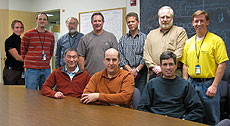From antiprotons to muons: Fermilab's newest department
 |
|
Clockwise, from left: Mary Convery, Dean Still, Tony Leveling, Jim Budlong, Jerry Annala, Steve Werkema, Brian Drendel, Jim Morgan, Al Sondgeroth and Vladimir Nagaslaev
|
With the shutdown of the Tevatron on Sept. 30, comes an overhaul of several machines used in the collider program. One particularly ambitious project is the repurposing of the Antiproton Source into a facility for the proposed Mu2e and Muon g-2 experiments. The first order of business is changing the name to the Muon Department to better reflect Fermilab's goals. "Our job now is to turn the Antiproton Source into a machine that can support both Muon experiments," said Jim Morgan, an engineering physicist working on converting the Transport Lines and Debuncher Ring. "And we need to do it as economically as possible."
Economically and environmentally more sound, part of the plan to cut costs is to reuse and recycle facilities, components and parts used in the collider program. It also helps that all of the people in the Muon Department worked on the Collider program, either in the Tevatron or Antiproton Departments or the Run Coordination team.
"It's challenging work to redesign the machines' former Pbar beam lines and rings using parts repurposed from collider operations," said Brian Drendel, an engineering physicist working on instrumentation and controls. "But having people who worked on the Tevatron or the Pbar is helpful because they really understand the equipment."
The equipment will be used differently, since the beam proposed for the Muon g-2 and Mu2e experiments will be delivered at a much faster rate than in collider operation, increasing the amount of beam that will be transported.
"Instrumentation and diagnostics will be redesigned because the beam properties required by the muon experiments are different than were required for Pbar operations," Drendel said. "In addition, the beam properties that will be seen in the Muon g-2 and Mu2e experiments are not the same, so we also need to make sure our plan accounts for the needs of both experiments."
It's a balancing act to repurpose the materials borrowed from the collider program that can overlap for both experiments. Jerry Annala, the head of the Muon Department, has to keep the big picture in sight.
"The people doing the work don't need that much oversight because they know what they're doing," Annala said. "They've worked with the equipment and they know it well."
Morgan agreed, but added that the process is bittersweet.
"Our part of the Mu2e and Muon g-2 projects is to make the accelerators work in their new role. Originally, the machine was built to create and store antiprotons, and we and others spent many years working to make it do that job exceptionally well. Now, we're basically dismantling a machine that was running the best that it ever had," Morgan said. "However, it is gratifying to know that we will be able to use so much of the old Antiproton Source to support two important future experiments. We are looking forward to the day when the muon machine is operational."
Operation is still a few years and a considerable amount of design effort away, so the team is focusing on the bright side.
"It's hard to say goodbye, but this is an incredible time for us," Drendel said. "We're going to see this project from its initial planning all the way to beam operations. That's exciting!"
The entire department has big expectations for the facility.
"We had such great success rate with the Tevatron program," Annala said. "We have high hopes for this project."
—Ashley WennersHerron
|